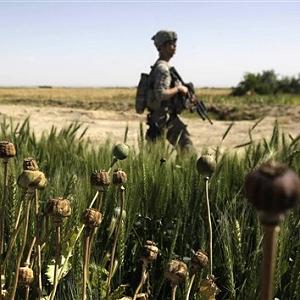KABUL — Eight percent of Afghans suffer from drug addiction, a rate twice the global average and a "major" growing problem for the world's leading narcotic producer, a survey warned Monday.

United States Army Staff Sgt. Jarrid Starks, of Omaha, Neb.,walk past a poppy field , front, bordered by wheat while patrolling with A Troop, 2nd Battalion, 1st Infantry Regiment of the 5th Stryker Brigade, Tuesday, April 27, 2010 in the Maiwand District of Kandahar Province. (Photo: AP)
Issued by the Afghan government and United Nations Office on Drugs and Crime (UNODC), the report found around one million people in the country aged 15 to 64 had drug addictions, often to opium and heroin."After three decades of war-related trauma, unlimited availability of cheap narcotics and limited access to treatment have created a major, and growing, addiction problem in Afghanistan," UNODC executive director Antonio Maria Costa said in a press statement.
"It's a bleak picture," said Robert Watkins the second-most senior UN official in Afghanistan, told a news conference, releasing the report in Kabul.Afghanistan is the leading producer of opium, the raw material for making heroin, and the survey found addiction could spread because drug users in north and south Afghanistan gave opium to their children.
The study also found that in the last five years the number of regular opium users had jumped 53 percent and the number of heroin users doubled as the drug industry boomed.
"In Afghanistan the growth of addiction to narcotics has followed the same hyperbolic pattern of opium production," Costa said.
The report added that only 10 percent of drug users surveyed had received any kind of drug treatment, even though 90 percent felt they needed it.

Saliha, a 4-year-old opium addict, sits on a hospital bed in Afghanistan's northern Balkh province May 26, 2008 with his sister Hamida, 10, and their addicted mother Malika, 35. In 25% of homes where adult addicts lived, children tested showed signs of significant drug exposure, according to the researchers. (Photo: ROSIE DIMANNO/TORONTO STAR)
Drug addiction treatment centres available in 21 of Afghanistan's 34 provinces could provide treatment for only a little more than 10,000 addicts, Ibrahim Azhar, a deputy counternarcotics minister told reporters.
Afghans were also addicted to cannabis, painkillers and tranquillisers, taking drugs "as a kind of self-medication against the hardships of life" in the war-torn country, which is battling a Taliban-led insurgency.
Afghanistan produces over 90 percent of the world's opium, mainly in the provinces of Helmand and Kandahar in the south and Farah in the southwest, a crop estimated worth 2.8 billion dollars a year.
VOA, June 21, 2010:
In a report released Monday, the U.N. Office on Drugs and Crime said 1 million Afghans are addicted to narcotics, with the number of opium users increasing more than 50 percent and heroin users by 140 percent since 2005



